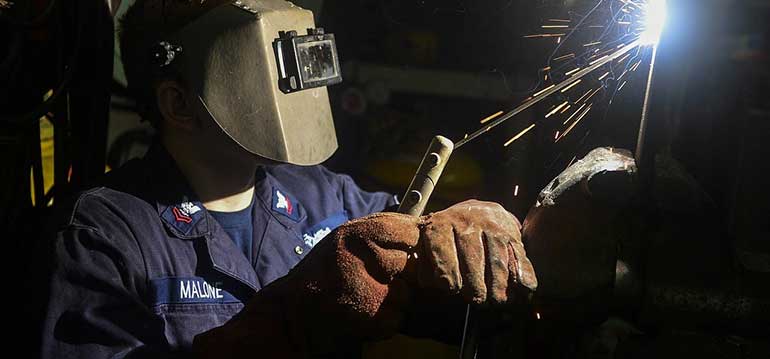Like any construction and electrical jobs, there are some common welding problems as well. It happens a lot when you have just started your welding career and there will be fewer problems when you become experienced.
Such problems may occur even though if you have a really high-end welding machine. So, if you have a cheap welding machine, don’t just blame it yet for such problems.
Being an expert in this field takes time. But you do not have to wait that long to identify those reasons why such welding problems occur. In this article, I will talk about those common problems in brief and mention why those problems occur.
10 Common Welding Problems

You will notice a lot of defects like incorrect shape, deformity, and other problems. As I said above, like every manufacturing defects, you will notice such problems in the welding too.
Once you know those problems, it will be easier to solve them so that they never occur in the future. So, here are some common welding problems that you should watch out:
- Welding Cracks
Among all those welding problems, crack is the most common and serious in nature. Over the passes of time, such cracks get larger. You can notice a crack on the surface or in the weld metal. There are so many reasons why welding crack happens.
One of the prime reason is poor joint design. If your welding speed is high but the current is low, the crack may happen. Besides, if the base metal is contaminated or the metal has a significant amount of carbon &sulfur, it may happen.
The problem with such cracks is that fixing them is not so simple. You can’t just fill the gap with the material. Most of the time, completely new welding is required. There are at least 3 types of welding cracks that you need to be aware of.
The first one is hot cracks. Mostly happens during the welding or crystallization process. The temperature may rise as high as 10K Celsius during this time. After the hot cracks, here come the cold cracks.
If there are any deformities in the steel structure, the cold cracks may happen when you are done welding and the temperature is gone. Such cracks may appear even days after!
And lastly, there comes the crater crack that happens at the end of the welding process and just before you pass on the weld joint. Here is how a welding crack can be solved.
- Problem of Spatter
This is not so common except Gas Metal Arc Welding (GMAW) process. It happens when molten material droplets get produced nearby the welding arc. Spatter can happen due to many reasons like high current, insufficient gas shielding, or incorrect polarity. Very dangerous for your skin and it will burn your precious shirts. So, wear a protective welding jacket to safeguard yourself from the spatter.
- Porosity/Welding Bubble
Sometimes, you will notice bubble filled weld due to the trapped gas inside. This eventually compromises the weld quality.
In addition to the contaminated weld metal, there are several other reasons why porosity happens like using too high gas flow, presence of moisture, rust, grease or oil, incorrect surface treatment, and so on.
- Wrong Wire Delivery
Sometimes within the gun cable, you will listen a chattering sound. This mainly happens due to the wrong wire delivery system and can result in imperfect weld quality. The same problem may occur if you use too large tips for the application.
- Problem of Incomplete Penetration
If the groove of the metal does not fill completely, you may have the problem of incomplete penetration. Several reasons could be behind this. Probably you are moving the bead too quickly?
Other reasons include using low amperage settings, improper joint, or maybe you are using too large electrode diameter.
- Slag Inclusion Problem
This problem is easily visible in the weld and this is simply a byproduct of the stick, flux-core, and submerged arc welding. Since, small flux particles get trapped inside the weld metal, there will be trouble for the complete penetration.
Along with improper cleaning, welding too fast, wrong welding angle, too low welding current, etc. are responsible for the slag problem.
- The Horrible Deformation
It happens during the contraction steps of the welded metals. In the contraction steps, it’s time for the cooling and hardening of the welded metal. This is when they get deformed. Wrong welding sequences, too many thin beads, lack of enough clamping prior to the welding, etc. are primarily responsible for deformation.
- Undercutting Issue
An undercut is another common welding problem. Lots of reasons behind this like a too long arc or too high voltage. Even an incorrect angle or incorrect electrode usage can lead to this problem. Too fast travel speed also can cause this problem too.
- Brittle Welding
Brittle weld never holds up this happens a lot in welding. Instead of using the shielded arc electrodes if you use bare electrodes of incorrect sizes – that will lead to brittle welding problem. Excessive using of current or if you do not pass over the weld several times – that may also cause brittle welding problem.
- Incomplete Fusion
In between the base metal weld metal; there should not be any lack of proper fusion. But sometimes that happens and only then these types of welding defects occur. Too fast travel speed, low heat input, incorrect electrode diameter, etc. lead to this problem.
Conclusion
Along with such common welding problems mentioned above, there are so many problems. Only good practice can solve this problem. Also, welding defects may result in safety hazards as well of which you should be careful. Wearing all of your safety gears like your auto-darkening welding helmet, gloves, glasses, etc. are so important.
